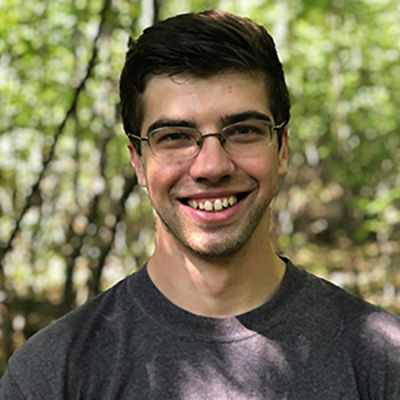Name: Brett Kuwik
Organization: Johns Hopkins University
Hometown: Pittsburgh, PA
Hobbies/Interests Outside of Work: Hiking, being outdoors, playing soccer
Research Area/Focus Area (as it relates to the MSEE URA): Research Area 1 / Focus Area 2: Material Properties and Failure / Materials Constitutive Laws
How does the MSEE URA and its collaborative nature benefit you?
In MSEE URA, many renowned researchers, each highly respected in their individual fields, are coming together for a common goal of better understanding and predicting materials and chemistries under extreme conditions. There are many hurdles that come when working in large groups; it can be challenging to fully communicate ideas and ensure that everybody is on the same page. This is especially true for MSEE URA where 40 PIs across 18 institutions are coming together. However, with these challenges there are many opportunities. In collaborative projects each individual brings a unique background and skill set, and a different method of thinking. Working in groups changes the mind set of individuals, fostering an environment where ideas can flow freely and openly, leading to innovative solutions. By working with MSEE URA I will be able to meet and collaborate with many researchers and understand and discuss different solutions strategies to research problems. With this collaboration I will be able to grow as a researcher and these skills to future projects after my PhD.
During my undergraduate studies I learned about the benefit of working on collaborative projects. I attended a small university where it was highly encouraged and necessary to collaborate both within the school and with collaborators in industry. During collaborations within the school, I often had the pleasure of working with artists who used ceramics as their media of choice. I was fascinated with artists, who would bring a different mindset than academics to a project. Often times, fully examining the different solution methods to a problem allows for a better understanding of the problem and the best path towards the solution can be seen. Within MSEE URA I will be able to collaborate with multiple individuals and will be encouraged to examine different solution methods. What excites me the most about MSEE URA is the open collaboration across multiple universities and labs and learning how different individuals approach research problems.
How will the MSEE URA will be improved through your involvement?
My contribution towards the MSEE URA is a unique set of skills and background that most researchers do not have. My background is quite unique as I am not a “typical” mechanical engineering; I would consider myself more of a ceramic engineer. This is because my undergraduate university (Alfred University) is one of the few universities that offers degrees in ceramic engineering and glass science. Although I was a mechanical engineering major, many of my classes were heavily influenced by the ceramics program. Gaining knowledge in mechanical and ceramic engineering was complementary and I was able to understand both the mechanics and processing of materials. I am able to understand how ceramic materials failed with a mechanical background and understand why objects failed with a ceramics background. These set of skills will be useful in the MSEE URA where I will work in the Material Properties and Failure and specifically the Materials Constitutive Models focus area.
After my time at Alfred University, I spent a year working at Oak Ride National Lab (ORNL) as a post-bachelor’s research associate mentored by Andy Wereszczak. During my yearlong appointment, I was able to build upon my previous lab experience that I obtained in undergrad and obtain a better fundamental understanding of research. While being mentored I was able to think more critically as a researcher and understand the type of questions that needed to be asked and what directions to take. One specific project I worked on was understanding the mechanical response of glasses as a function of their Poisson’s ratio using spherical indentation. The project encountered unexpected problems that were not foreseen. However, by learning how to overcome unexpected problems, I was able to mature as a researcher and I will be able to bring this skill set to the MSEE URA.
Describe your plans for collaboration within and external to the URA.
My plan for collaboration within and external to URA is to understand and learn the skills and background that each individual researcher brings. With over 40 PIs across 18 institutions it can be difficult for individual voices to be heard, but by better understanding the skills and background of individuals, a greater sense of community can be established and individuals can feel open to expressing ideas. In addition, it is also extremely important to constantly make sure everybody is on the same page, speaking the same language and feeling open to contributing to discussions. To accomplish this, communication chains will be established through email and regular focused meetings that allow for group discussions. With successful communication, successful collaborations within the URA will be established.

